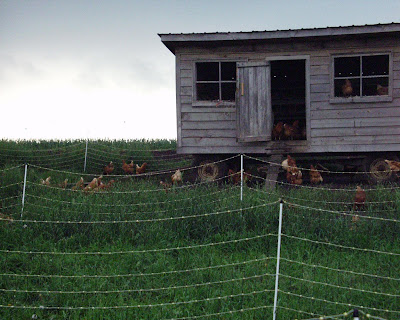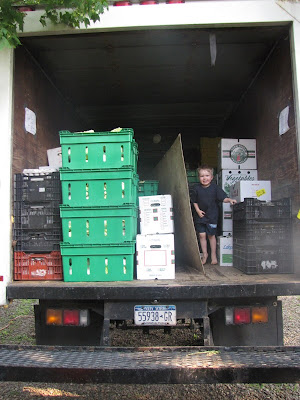 The little pods of fresh soybean (edamame) dangle from a jungle of foliage. They're time consuming to pick but most worth it.
The little pods of fresh soybean (edamame) dangle from a jungle of foliage. They're time consuming to pick but most worth it.
Usually in the weekly farm letter we focus on what’s been going on at the farm for the week. But since some members have been inquiring about how the farm is doing (and how our son is faring), we thought we’d talk about the big picture this week.
To be honest, it has been a frustrating growing season. Granted, we’re lucky we aren’t in Texas, where they’re experiencing record drought, or in the Midwest, where there was so much rain this spring that CSA farms were unable to offer members shares until mid-July. But here in Upstate New York the growing conditions this year have been challenging.
We are still seeing long-term negative effects of the sopping wet spring. Many of our crops that should be flourishing right now, like melons, aren’t producing what they should. We were forced to plant them in unrelenting wet conditions, and, consequently, many transplants drowned or their root systems rotted underground. Seed washed away. We probably got at best 1/3 of the sweet corn crop we had planted, and our first melon planting failed from root rot. We were stuck—we couldn’t hold plants in the greenhouse any longer than we did, or they’d become what is called “root bound,” so we were forced to plant into subpar conditions.
Hudson Valley orchard farmer and friend Tom Maynard suffered an 85 percent loss on his cherry crop early this summer because of this spring’s wet weather. That is, with the lack of sun, the trees didn’t photosynthesize at an adequate rate, which affected the blossoms ability to produce fruit. For Tom, his cherry crop is what typically covers his labor costs. No small loss.
Shawn Cleland, owner of nearby Timberlane Blueberry Farm, said the wet spring significantly compromised her crop too. When the bees arrived in mid-May there were no blossoms on the blueberry bushes for them to pollinate (the blossoms arrived about a month late). “We had no humming this year,” she said in reference to the usual bee activity. This week is probably the last of the blueberries that we’ll see. In a good year, she’d normally have another 3 weeks to harvest.
The one crop that liked all that ridiculous spring rain was our garlic crop. It did well. Phew.
Then came July. As the NOAA’s National Climatic Data Center summed up: “Persistent, scorching heat in the central and eastern regions of the United States shattered long-standing daily and monthly temperature records… making it the fourth warmest July on record nationally.” The NOAA noted, too, that the heat wave was marked by higher than normal overnight and early morning temperatures. That is, to the detriment of our hen flock, temperatures at night stayed high through the heat wave.
In the fields, we are still seeing some of the effects of the extreme heat we had in July. For instance, our peppers and eggplant experienced something called “blossom drop.” That is, the flowers on the plants fell off during the heat wave. It is from these flowers that the vegetables are produced on the plants. We are just now seeing new blossoms, but by the time they generate more “fruit,” the plants will probably be killed off by frost.
We planted a tremendous tomato crop, and it was looking beautiful up until blight and fungal disease arrived. We did everything right—we planted the tomatoes in a field where we’d never planted tomatoes before (thus reducing chance of picking up soil-born disease), they were pruned right and planted right. But air-borne disease blew in aggressively killing the tomato plants’ foliage and leaving spots on the tomatoes. So our crop has been compromised.
Even though we planted significantly more than was necessary for the CSA this year as a safeguard, overall yields have been disappointing on a wide variety of crops and some crops we completely lost. The quality of many items hasn’t been as top notch as we expect because of this year’s weather conditions. We hate to say it but…it has not been a banner year.
The weather this year has underscored some concerns we have about what kind of a long-term future is in store for farmers if the weather extremes we’ve experienced in the last few years truly are due to climate change and are to become the “new normal.” NPR’s Terry Gross/Fresh Air ran a compelling interview of climatologist Heidi Cullen on this subject a couple of weeks ago. When things slow down here (come winter) we plan to get a copy of Cullen’s book The Weather of the Future: Heat Waves, Extreme Storms, and other Scenes from a Climate Changed Planet. Maybe some of you, too, heard the interview. What she said really spoke to us in terms of what we have been observing.
Despite the setbacks, each week we have been able to drum up a sizable share and new crops keep arriving. This week’s purple beans, for instance, look gorgeous. And we are pleased to offer fresh edamame this week—something our staff had to spend hours picking (a very tedious crop to pick) and that you normally only see frozen (see tips, in newsletter, on how to cook fresh). This crop is a treat.
Update on Xavier: Our 3 ½-year-old son seems to be doing fine. Unfortunately, we don’t know what was wrong with him back in late June when we ended up 3 times in the emergency room and overnight in the hospital for a couple of days. The doctors were stumped and released him with a diagnosis of most likely having neurological complications, possibly from a concussion. Fortunately, Xavier’s symptoms have not recurred for more than a month. Needless to say, it was impossible to neatly compartmentalize that ordeal while trying to keep up with the demands of the farm. We greatly appreciate the e-mails, cards and well wishes we received. They really helped to carry us through a stressful couple of weeks.
IN THIS WEEK’S SHARE
2 white, large mild onions (great for kebabs and on the grill)
¾ pound velour stringless beans (see below)
1 pound edamame (fresh soy bean)
1 bunch basil
1 bunch amaranth greens (see below)
Eggplant
Tomatoes
1 additional item to be determined (broccoli, Romanesco cauliflower or gold beets)
 Amaranth Greens:
Amaranth Greens:That curious bouquet of purpley-red and green leaves is back this week. Known as amaranth greens or Asian spinach, we have had a lot of farmers' market customers try it on a whim and come back the next week anxious for more. We hope you're just as glad to try it again. At the farm on Sunday, we cooked it as follows and served over a bed of quinoa and alongside some grilled zucchini and grilled sliced onions (also in this week's share). So healthy. We had some balsamic vinegar on hand to drizzle over it, but it was so tasty, we never opened the bottle.
To cook the amaranth greens: Pluck the leaves from the stem, rinse and pat dry with a towel or spin dry in a salad spinner. (Discard the stems.) Mince 1 to 2 cloves of garlic.
In a heavy-bottomed saute pan or a cast iron fry pan, heat a few tablespoons of extra-virgin olive oil over medium heat. Add the garlic, stirring, until fragrant. Increase the heat to medium-high, add the greens, and toss with tongues to coat the greens with the oil and mix them with the garlic. Continue to cook until the greens have lightly wilted, about 3 minutes.
Season with Kosher salt to taste. If you wish, add a splash of balsamic vinegar or squeeze of lemon juice.
Edamame: Pronounced like eh-dah-mah-may. That would be the name for the fuzzy little pods containing nutty little fresh soybeans in this week's share. Kids and adults alike love this finger food. Very simple, very, very tasty.
To cook: Bring a large pot of salted water to a boil.
Carefully add the edamame in their pods (no shelling necessary) so as not to splash yourself.
Cook for 5 to 6 minutes. To test for doneness run a cooked pod under cold water to cool slightly and then slip a bean out of the pod. The bean should be firm, yet give to the teeth. Mushy beans means that they are over cooked.
Drain in a colander and let cool to room temperature, or refrigerate for a couple of hours to serve cold. Before serving, toss the pods with a generous pinch of Kosher salt.
To eat, slip the beans out and into your mouth by pulling the pods between your teeth. Discard the pods.
 A Note from the farm about the purple beans:
A Note from the farm about the purple beans:This week’s purple velour filet beans are a “haricot vert”—a very slender, stringless bean that’s a favorite of chefs. We sautéed some as they came in from the field, and they are deliciously tender and flavorful when cooked for just a few minutes in a skillet over medium-high heat in some extra-virgin olive oil with a sprinkling of coarse or Kosher salt to finish. Sadly, as with so many purple varieties of produce, they will not hold their deep burgundy color once cooked. So if you want to showcase their color, serve raw in a salad or with a dip.


















